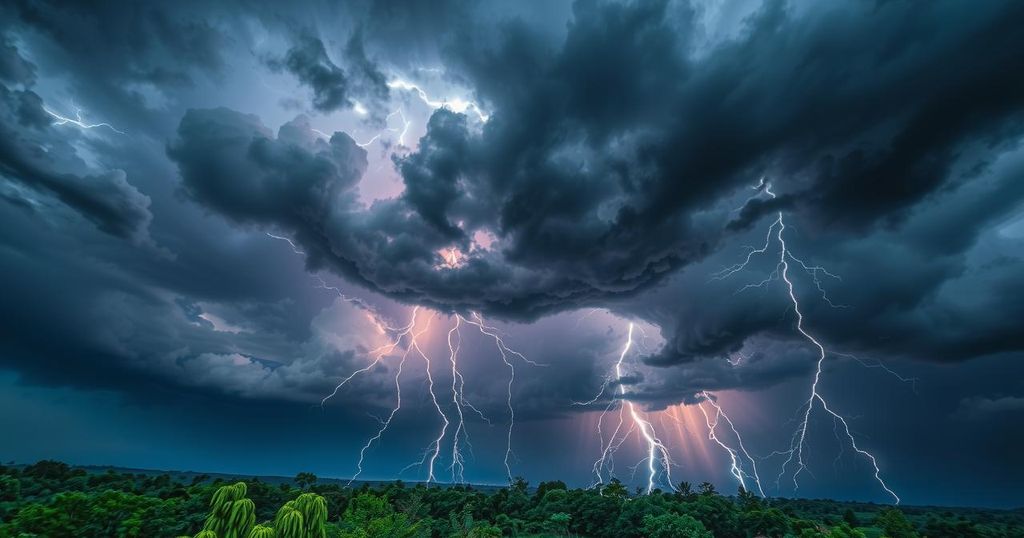Fatal Thunderstorms in Northern India Linked to Unusual Weather Patterns
A severe thunderstorm in northern India on Wednesday resulted in at least 59 fatalities across two states. Experts attribute the storm’s intensity to the unusual persistent weather patterns and strong atmospheric conditions, exacerbated by Arctic warming. They caution that these changes could significantly affect the forthcoming monsoon season.
A devastating thunderstorm swept through northern India on Wednesday, resulting in the tragic deaths of at least 59 individuals across two states, according to officials. This storm, which wreaked havoc on the region, is being linked to an unusual mix of weather patterns and ongoing winter disturbances that are seemingly affecting the monsoon season.
Meteorologists have described this storm as a product of a peculiar atmospheric mix. A combination of cyclonic circulations, high moisture levels from two adjacent seas, and intense daytime heat all converged, worsened by the ongoing influence of Western Disturbances, a winter weather system that typically shows signs of retreat during the summer months. This situation has raised eyebrows as it’s been observed that these disturbances are hanging around longer than expected.
M Rajeevan, former secretary of the Ministry of Earth Sciences, commented on the unusual persistence of these disturbances.
“We expect Western Disturbances to move north of the Indian region in April, May, June months. But in some years, we are seeing their impact continuing in summer, which is not good for the monsoon.” He elaborated that multiple studies suggest a shift in the active season of Western Disturbances, possibly due to the diminishing Arctic sea ice impacting circulation patterns.
This weather pattern that affected India closely mirrors unseasonably warm temperatures thousands of miles away—record highs in areas like the Arctic Circle seem to be driving colder air southward, resulting in atypically cold conditions in regions like the US Eastern Seaboard.
Wednesday’s storm was attributed to a combination of cyclonic circulation and troughs affecting northern India. Rajeevan noted, “The atmosphere became unstable, like bubbles, which can lead to rain and thunderstorms.” Indeed, experts consider such multiple systems emerging simultaneously somewhat rare, although not entirely out of the question. Rajeevan urged vigilance regarding whether these developments could disrupt the monsoon’s overall progression.
Even though officials from the Indian Meteorological Department (IMD) stated there was no active Western Disturbance over northwest India on that day, Mahesh Palawat, vice president at Skymet, offered a more nuanced view, indicating these thunderstorms are indeed influenced by mild disturbances in the region. He forecasted light dust storms and possible thunderstorms across northwest India from May 25 to May 27, along with a drop in regional temperatures.
The regions affected faced a variety of weather-related incidents, particularly in Uttar Pradesh, where multiple fatalities occurred as a consequence of lightning strikes. A 65-year-old man and a six-year-old girl were among those who tragically lost their lives. Structural collapses were also deadly; an 80-year-old woman died when her house’s wall collapsed, and a 26-year-old man was killed due to falling debris from a construction site.
In Delhi, wind speeds hit alarming levels—up to 79 km/h at certain locations—and the temperature dramatically dropped from 37°C to 23°C within an hour. Rainfall measurements noted up to 13.5mm, leading to operational delays at the Indira Gandhi International Airport and disrupting metro services across several lines.
Looking ahead, the IMD has indicated that a low-pressure area in the Arabian Sea could strengthen into a depression, which might lead to an earlier-than-usual monsoon in Kerala, potentially starting a few days ahead of the typical June 1 onset date. However, Rajeevan offered a cautionary note that persistent winter disturbances could hinder the northward advance of the monsoon, hinting at fundamental shifts in atmospheric circulation patterns.
“A continued presence of these disturbances may hinder the monsoon’s progress,” he remarked, highlighting the implications for agriculture and infrastructure.
This severe weather incident not only underscores the impact of climate change but also serves as a critical reminder of how distant atmospheric phenomena can alter weather patterns, reshaping India’s climatic landscape and affecting the livelihoods of millions.
The recent devastating thunderstorm in northern India, which claimed 59 lives, illustrates the severe impact of unusual weather patterns driven by persistent winter disturbances and atmospheric instability. Experts warn that changes in climate and Arctic warming are influencing weather systems, potentially disrupting the essential monsoon. As the region faces these ongoing challenges, the implications for agriculture and infrastructure are significant and demand close attention.
Original Source: www.hindustantimes.com




Post Comment